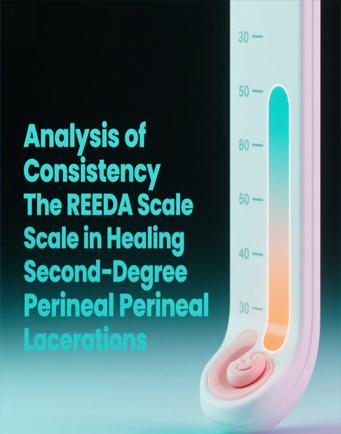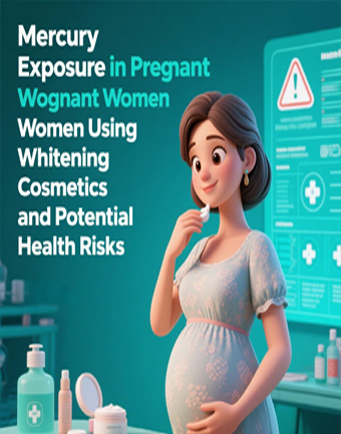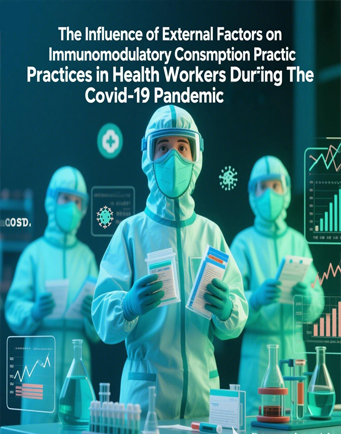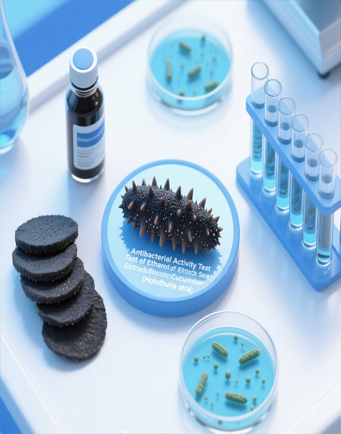The Role of the Family in Preventing the Transmission of COVID-19 in Children
Downloads
COVID-19 is a disease that is highly communicable from infected individuals to others who are susceptible to infection. The family is the first line of defense against the spread of the COVID-19 epidemic among youngsters. There is transmission of the COVID-19 virus to children notwithstanding the inadequacy of parental efforts to prevent such transmission. The effect of COVID-19 infection on unfit parents will result in the transmission of the virus to offspring. The incidence of COVID-19 in children is influenced by the level of parental knowledge and conduct to avoid the transfer of the virus. The purpose of this study is to examine the relationship between parents' activities and attitudes regarding COVID-19 prevention, the detection of COVID-19 symptoms in children, and the level of information regarding the prevalence of COVID-19 in children. The research design employs a cross-sectional observational analysis. This study's demographic and sample consisted of proportional samples from 12 Community Health Centers, with 550 family respondents in total. The results of this study indicate that delivering the COVID-19 vaccination to the family considerably reduces the risk of COVID-19 transmission to children. The level of family knowledge correlates strongly with the transmission of COVID-19 to children (a symp=0.001, with a correlation p-value of 0.669). There is a correlation between the administration of the COVID-19 vaccine to parents and the transmission of the virus to children (symp=0.001, p=0.660). Based on the results of the study, there was a significant influence between the level of parental knowledge on the behavior of preventing COVID-19 in children in Kupang City. In addition, there is a significant relationship between the behavior and attitudes of parents who are disobedient in preventing COVID-19 in children and the incidence of COVID-19 in children. Families or parents who carry out the COVID-19 vaccination in the family also have a significant relationship with the transmission of the COVID-19 virus to children. To reduce the transmission of COVID-19 to children, efforts from the family are needed, such as implementing health protocols and carrying out vaccinations.
Adeyinka, A., Bailey, K., Pierre, L., & Kondamudi, N. (2021). COVID 19 infection: pediatric perspectives. Journal of the American College of Emergency Physicians Open, 2(1), e12375. https://doi.org/10.1002/emp2.12375
Anantyo, D. T., Kusumaningrum, A. A., Rini, A. E., Radityo, A. N., Rahardjani, K. B., & Sarosa, G. I. (2020). Coronavirus Disease 2019 (COVID-19) Pada Anak (Studi Literatur). Medica Hospitalia: Journal of Clinical Medicine, 7(1A), 344-360. https://doi.org/10.36408/mhjcm.v7i1A.479
Assaker, R., Colas, A. E., Julien-Marsollier, F., Bruneau, B., Marsac, L., Greff, B., ... & Dahmani, S. (2020). Presenting symptoms of COVID-19 in children: a meta-analysis of published studies. British journal of anaesthesia, 125(3), e330-e332. https://doi.org/10.1016/j.bja.2020.05.026
Ashidiqie, M. L. I. I. (2020). Peran Keluarga Dalam Mencegah Coronavirus Disease 2019. SALAM: Jurnal Sosial Dan Budaya Syar-I, 7(8), 911-922.
Bandi, S., Nevid, M. Z., & Mahdavinia, M. (2020). African American children are at higher risk for COVID‐19 infection. Pediatric Allergy and Immunology. 31(7): 861–864. https://publons.com/publon/10.1111/PAI.13298
Blumberg, T. J., Adler, A. C., Lin, E. E., Fazal, F. Z., Talwar, D., Ellingsen, K., ... & Shah, A. S. (2020). Universal screening for COVID-19 in children undergoing orthopaedic surgery: a multicenter report. Journal of Pediatric Orthopaedics, 40(10), e990-e993. https://doi.org/10.1097/BPO.0000000000001657
CDC. (2020). Bridged race population estimates. Atlanta, GA: US Department of Health and Human Services, CDC.
CDC. (2020). Coronavirus disease 2019 (COVID-19): cases in U.S. Atlanta, GA: US Department of Health and Human Services, CDC.
Dong, Y., Mo, X., Hu, Y., Qi, X., Jiang, F., Jiang, Z., & Tong, S. (2020). Epidemiology of COVID-19 Among Children in China. Pediatrics, 145(6), e20200702. https://doi.org/10.1542/peds.2020-0702
Ernawati, K., Cantika, I. B., Isaputri, R. R., Andari, A. W., Ramadhan, M. F., Nathasia, S. K., ... & Ismail10, Y. (2021). Community knowledge, attitudes and behaviors in prevention of covid-19 transmission: A systematic review. International Journal of Public Health Science, 10(1), 16-26. http://doi.org/10.11591/ijphs.v10i1.20664
Graff, K., Smith, C., Silveira, L., Jung, S., Curran-Hays, S., Jarjour, J., ... & Abuogi, L. (2021). Risk factors for severe COVID-19 in children. The Pediatric Infectious Disease Journal, 40(4), e137-e145. https://doi.org/10.1097/INF.0000000000003043
Han, X., Li, X., Xiao, Y., Yang, R., Wang, Y., & Wei, X. (2021). Distinct characteristics of COVID-19 infection in children. Frontiers in Pediatrics, 9, 619738. https://doi.org/10.3389/fped.2021.619738
Ho, C. L. T., Oligbu, P., Ojubolamo, O., Pervaiz, M., & Oligbu, G. (2020). Clinical characteristics of children with COVID-19. AIMS Public Health, 7(2), 258-273. https://doi.org/10.3934/publichealth.2020022
Huang, X., Wei, F., Hu, L., Wen, L., & Chen, K. (2020). Epidemiology and clinical characteristics of COVID-19. Archives of Iranian medicine, 23(4), 268-271. http://doi.org/10.34172/aim.2020.09
Liu, W., Zhang, Q. I., Chen, J., Xiang, R., Song, H., Shu, S., ... & Liu, Y. (2020). Detection of Covid-19 in children in early January 2020 in Wuhan, China. New England Journal of Medicine, 382(14), 1370-1371. https://doi.org/10.1056/NEJMc2003717
Lu, X., Zhang, L., Du, H., Zhang, J., Li, Y. Y., Qu, J., ... & Wong, G. W. (2020). SARS-CoV-2 infection in children. New England Journal of Medicine, 382(17), 1663-1665. https://doi.org/10.1056/NEJMc2005073
Ludvigsson, J. F. (2020). Systematic review of COVID‐19 in children shows milder cases and a better prognosis than adults. Acta paediatrica, 109(6), 1088-1095. https://doi.org/10.1111/apa.15270
Mustajab, D., Bauw, A., Rasyid, A., Irawan, A., Akbar, M. A., & Hamid, M. A. (2020). Working from home phenomenon as an effort to prevent COVID-19 attacks and its impacts on work productivity. TIJAB (The International Journal of Applied Business), 4(1), 13-21.
Naja, M., Wedderburn, L., & Ciurtin, C. (2020). COVID-19 infection in children and adolescents. British Journal of Hospital Medicine, 81(8), 1-10. https://doi.org/10.12968/hmed.2020.0321
Natera-de Benito, D., Aguilera-Albesa, S., Costa-Comellas, L., García-Romero, M., Miranda-Herrero, M. C., Rúbies Olives, J., ... & Nascimento, A. (2021). COVID-19 in children with neuromuscular disorders. Journal of Neurology, 268(9), 3081-3085. https://doi.org/10.1007/s00415-020-10339-y
Pavone, P., Ceccarelli, M., Taibi, R., La Rocca, G., & Nunnari, G. (2020). Outbreak of COVID-19 infection in children: fear and serenity. Eur Rev Med Pharmacol Sci, 24(8), 4572-4575.
Sari, N. N., Agata, A., & Patria, A. (2020). Factors Affecting Covid-19 Disease Prevention Behavior in Bandar Lampung, Indonesia. Journal for Quality in Public Health, 4(1), 140-146. https://doi.org/10.30994/jqph.v4i1.129
She, J., Liu, L., & Liu, W. (2020). COVID‐19 epidemic: disease characteristics in children. Journal of medical virology, 92(7), 747-754. https://doi.org/10.1002/jmv.25807
Shelmerdine, S. C., Lovrenski, J., Caro-Domínguez, P., & Toso, S. (2020). Coronavirus disease 2019 (COVID-19) in children: a systematic review of imaging findings. Pediatric radiology, 50, 1217-1230. https://doi.org/10.1007/s00247-020-04726-w
Shen, K., Yang, Y., Wang, T., Zhao, D., Jiang, Y., Jin, R., ... & Gao, L. (2020). Diagnosis, treatment, and prevention of 2019 novel coronavirus infection in children: experts’ consensus statement. World journal of pediatrics, 16(3), 223-231. https://doi.org/10.1007/s12519-020-00343-7
Sinha, I. P., Harwood, R., Semple, M. G., Hawcutt, D. B., Thursfield, R., Narayan, O., ... & Southern, K. W. (2020). COVID-19 infection in children. The Lancet Respiratory Medicine, 8(5), 446-447.
Syadidurrahmah, F., Muntahaya, F., Islamiyah, S. Z., Fitriani, T. A., & Nisa, H. (2020). Perilaku physical distancing mahasiswa UIN Syarif Hidayatullah Jakarta pada masa pandemi covid-19. Perilaku dan Promosi Kesehatan: Indonesian Journal of Health Promotion and Behavior, 2(1), 29-37. http://dx.doi.org/10.47034/ppk.v2i1.4004
Wajdi, M. B. N., Kuswandi, I., Al Faruq, U., Zulhijra, Z., Khairudin, K., & Khoiriyah, K. (2020). Education policy overcome coronavirus, a study of Indonesians. EDUTEC: Journal of Education And Technology, 3(2), 96-106.
WHO. (2020). Coronavirus disease (COVID-2019) situation reports. WHO . Retrieved from https://www.who.int/docs/default-source/coronaviruse/situation-reports/20200620-covid-19-sitrep-152.pdf
Woodruff, R. C., Campbell, A. P., Taylor, C. A., Chai, S. J., Kawasaki, B., Meek, J., ... & Havers, F. (2022). Risk factors for severe COVID-19 in children. Pediatrics, 149(1), e2021053418.
Yuliana, Y. (2020). Corona virus diseases (Covid-19): Sebuah tinjauan literatur. Wellness And Healthy Magazine, 2(1), 187-192.
Zimmermann, P., Pittet, L. F., & Curtis, N. (2021). How common is long COVID in children and adolescents?. The Pediatric infectious disease journal, 40(12), e482. https://doi.org/10.1097/INF.0000000000003328
Copyright (c) 2023 JURNAL INFO KESEHATAN

This work is licensed under a Creative Commons Attribution-NonCommercial-ShareAlike 4.0 International License.
Copyright notice
Ownership of copyright
The copyright in this website and the material on this website (including without limitation the text, computer code, artwork, photographs, images, music, audio material, video material and audio-visual material on this website) is owned by JURNAL INFO KESEHATAN and its licensors.
Copyright license
JURNAL INFO KESEHATAN grants to you a worldwide non-exclusive royalty-free revocable license to:
- view this website and the material on this website on a computer or mobile device via a web browser;
- copy and store this website and the material on this website in your web browser cache memory; and
- print pages from this website for your use.
- All articles published by JURNAL INFO KESEHATAN are licensed under the Creative Commons Attribution 4.0 International License. This permits anyone to copy, redistribute, remix, transmit and adapt the work provided the original work and source is appropriately cited.
JURNAL INFO KESEHATAN does not grant you any other rights in relation to this website or the material on this website. In other words, all other rights are reserved.
For the avoidance of doubt, you must not adapt, edit, change, transform, publish, republish, distribute, redistribute, broadcast, rebroadcast or show or play in public this website or the material on this website (in any form or media) without appropriately and conspicuously citing the original work and source or JURNAL INFO KESEHATAN prior written permission.
Permissions
You may request permission to use the copyright materials on this website by writing to jurnalinfokesehatan@gmail.com.
Enforcement of copyright
JURNAL INFO KESEHATAN takes the protection of its copyright very seriously.
If JURNAL INFO KESEHATAN discovers that you have used its copyright materials in contravention of the license above, JURNAL INFO KESEHATAN may bring legal proceedings against you seeking monetary damages and an injunction to stop you using those materials. You could also be ordered to pay legal costs.
If you become aware of any use of JURNAL INFO KESEHATAN copyright materials that contravenes or may contravene the license above, please report this by email to jurnalinfokesehatan@gmail.com
Infringing material
If you become aware of any material on the website that you believe infringes your or any other person's copyright, please report this by email to jurnalinfokesehatan@gmail.com.





































